 For a larger version of this image go here.
For a larger version of this image go here.
While on a recent visit to Tokyo, I spent four mornings exploring and taking photos of Tsukiji, the world famous seafood market. The highlight of the market for many is the famous tuna auction, which in the last decade has actually become a huge tourist destination. During each of my visits there were at least a hundred or more visitors, standing in the way, taking photos (often with flash, although very large signs asked that people not do this), and posing with the fish. Tiny forklifts are constantly buzzing by at breakneck speed, and the floor is very slippery--clearly not a place for tourists. Being Japanese, the bidders and auctioneers involved in the market were typically polite, but I could sense their frustration. In recent years this madness has reached tipping point, and there's word that since April this part of the market should now be closed to tourists.
As shown above and below, there are several expansive rooms lined with fresh and frozen tuna:

From about 5-6am the potential buyers carefully inspect the tuna, making notes:

looking closely:

and often tasting and smelling the tuna (spitting the meat out on the floor, to my surprise). When inspections are done, a bell rings and the auction takes place:

The highest bidders take their wares off to the interior of the market to be cut and prepared:

This was fascinating, but there's a lot more at Tsukiji than tuna. The entire market covers several cold and wet warehouses:

encompassing virtually every kind of seafood imaginable, from beautiful shrimp:

to crabs:

and fish:

Apparently the entire market is slated to move to another part of town in the next couple years, and will, I've heard, not be as open as the current one.
The entire photoset can be seen here.












 It didn't take me long to discover that, unless you're a fan of mediocre Swedish food or bland Thai/Asian, you'll find little of interest to eat on the island of Phuket. The exception to this was Phuket Town, by far the most interesting and atmospheric place on the island, and virtually forgotten by the hordes of tourists who cling to the beaches. I was surprised to find that many of the traditional dishes you'll find there are nearly identical to
It didn't take me long to discover that, unless you're a fan of mediocre Swedish food or bland Thai/Asian, you'll find little of interest to eat on the island of Phuket. The exception to this was Phuket Town, by far the most interesting and atmospheric place on the island, and virtually forgotten by the hordes of tourists who cling to the beaches. I was surprised to find that many of the traditional dishes you'll find there are nearly identical to 







 I’m currently in Tokyo, so this is what my curries will be looking like for the next few days. I love this city and am here taking photos at Tsukiji, the world-famous seafood market, for a magazine article. Will post some pics from that, as well as some of the fun food I had in Phuket just before coming here, soon.
I’m currently in Tokyo, so this is what my curries will be looking like for the next few days. I love this city and am here taking photos at Tsukiji, the world-famous seafood market, for a magazine article. Will post some pics from that, as well as some of the fun food I had in Phuket just before coming here, soon. At a smoking area, Shibuya, Tokyo, Japan.
At a smoking area, Shibuya, Tokyo, Japan.



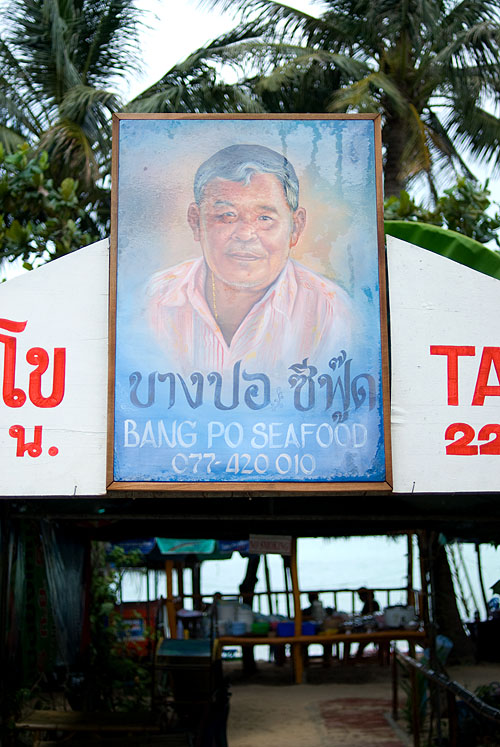 Throwing around superlatives can be a scary thing, but I think I'm justified in this case. I've been to many, many restaurants in Thailand, and have eaten some pretty amazing food, but Bangpo Seafood particularly stands out in my mind. I knew something was special about it after my first visit over a year ago, and wrote
Throwing around superlatives can be a scary thing, but I think I'm justified in this case. I've been to many, many restaurants in Thailand, and have eaten some pretty amazing food, but Bangpo Seafood particularly stands out in my mind. I knew something was special about it after my first visit over a year ago, and wrote 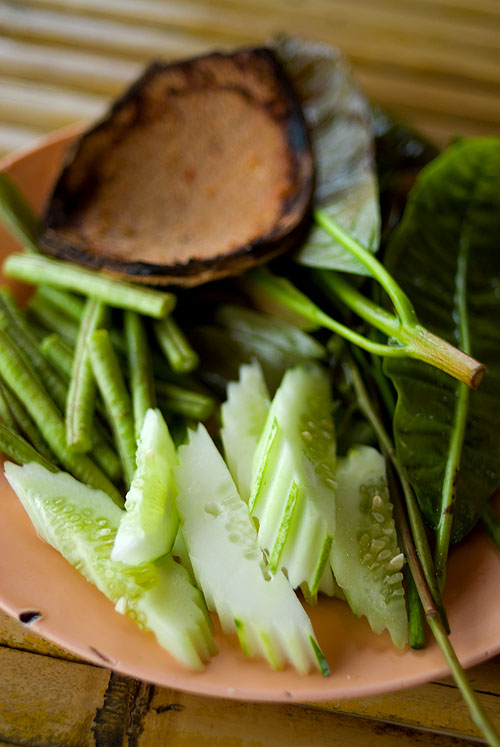


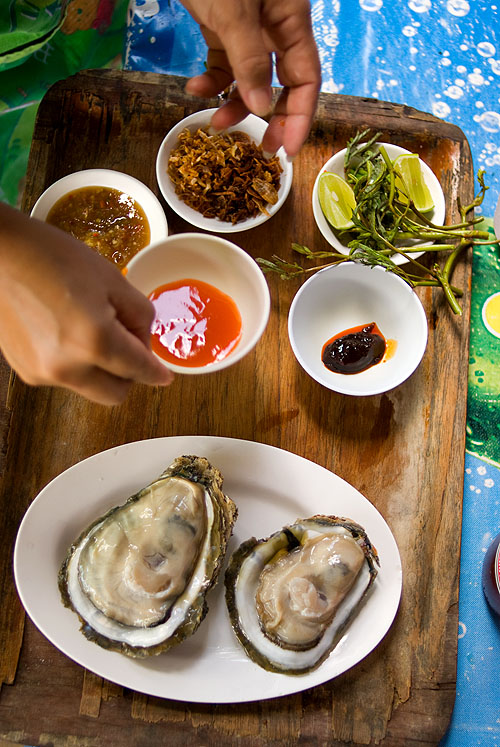
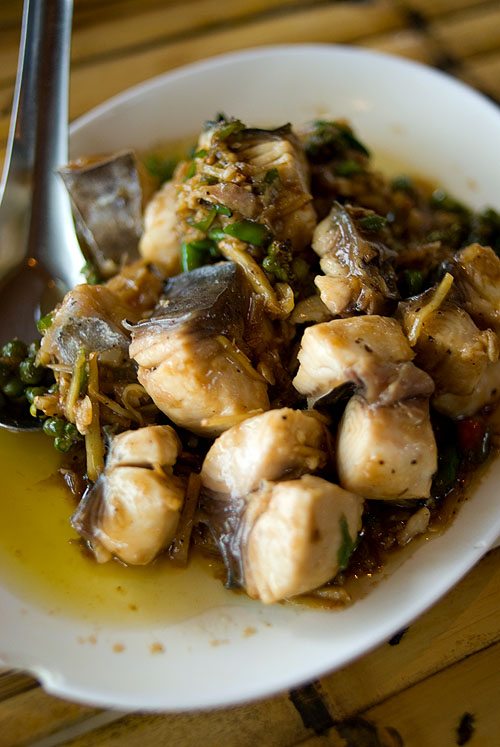

 Dancing ladyboys along Thanon Bangla, Patong, Phuket, of course:
Dancing ladyboys along Thanon Bangla, Patong, Phuket, of course:
 Reproducing famous works of art at Chaweng Beach, Ko Samui.
Reproducing famous works of art at Chaweng Beach, Ko Samui. Lunch at an unidentified curry restaurant, Ko Samui. Isn't food beautiful?
Lunch at an unidentified curry restaurant, Ko Samui. Isn't food beautiful? This pic makes me smile. She was originally from Bangkok, is a housekeeper at one of the big hotels at night, and by day is a vendor on Chaweng. Buy something from her if you see her!
This pic makes me smile. She was originally from Bangkok, is a housekeeper at one of the big hotels at night, and by day is a vendor on Chaweng. Buy something from her if you see her! After several days on Ko Samui, I officially have no more reason to bitch about the lack of local eats. While staying on Lamai beach I discovered a stall at nearby Talat Dao that sells a variety of khanom jeen, curries served over fresh rice noodles. This is possibly the most common dish in southern Thailand, and is served at all times of day or night. Khanom jeen can also be got in other parts of Thailand, but what makes it different down here are the types of curries served and the toppings. Southern Thais like their chili heat, and the innocent looking, typically yellowish curries you'll see here are some of the spiciest in the country. The one pictured above is called naam yaa plaa (pictured above), and is a fish and coconut milk-based curry particular to the south. As with all types of khanom jeen, when you order you'll simply get a shallow bowl with a handful of noodles and a ladleful of curry. It's your job to top it with the fresh herbs and veggies held in vast trays on the tables. These herbs typically include a couple kinds of basil, young cashew nut leaves, phak chee lawm (an herb almost identical to flat leaf parsley, pictured above) cucumbers, long beans and a couple types of pickled veggies. It's all for free and you simply take what you like, rip it all up and mix it into your noodles.
After several days on Ko Samui, I officially have no more reason to bitch about the lack of local eats. While staying on Lamai beach I discovered a stall at nearby Talat Dao that sells a variety of khanom jeen, curries served over fresh rice noodles. This is possibly the most common dish in southern Thailand, and is served at all times of day or night. Khanom jeen can also be got in other parts of Thailand, but what makes it different down here are the types of curries served and the toppings. Southern Thais like their chili heat, and the innocent looking, typically yellowish curries you'll see here are some of the spiciest in the country. The one pictured above is called naam yaa plaa (pictured above), and is a fish and coconut milk-based curry particular to the south. As with all types of khanom jeen, when you order you'll simply get a shallow bowl with a handful of noodles and a ladleful of curry. It's your job to top it with the fresh herbs and veggies held in vast trays on the tables. These herbs typically include a couple kinds of basil, young cashew nut leaves, phak chee lawm (an herb almost identical to flat leaf parsley, pictured above) cucumbers, long beans and a couple types of pickled veggies. It's all for free and you simply take what you like, rip it all up and mix it into your noodles.
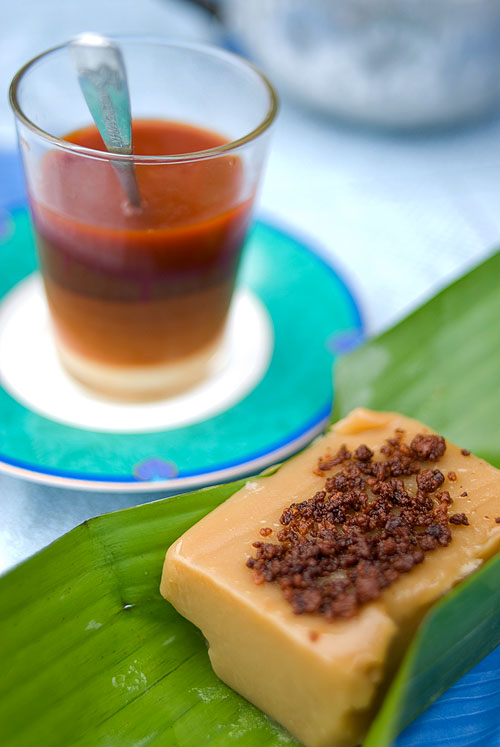 I've been on Ko Samui for almost a week now, and although finding real Thai food is not impossible, it can be something of a struggle. While on Lamai Beach I had a handsome meal of bangers and mash, was tempted to order pizza ('Chef from Naples'), and one night ate dinner at, uh... a Swedish restaurant (falukorv med stekt potatis och äkta svensk senap!). These were all satisfying, but I was still longing for something... local. I finally found it the next morning at Lamai's morning market. There I had a breakfast of sweet Thai tea with a Thai sweet (pictured above--name forgotten). Sweet, yes, but Thai. More to follow...
I've been on Ko Samui for almost a week now, and although finding real Thai food is not impossible, it can be something of a struggle. While on Lamai Beach I had a handsome meal of bangers and mash, was tempted to order pizza ('Chef from Naples'), and one night ate dinner at, uh... a Swedish restaurant (falukorv med stekt potatis och äkta svensk senap!). These were all satisfying, but I was still longing for something... local. I finally found it the next morning at Lamai's morning market. There I had a breakfast of sweet Thai tea with a Thai sweet (pictured above--name forgotten). Sweet, yes, but Thai. More to follow...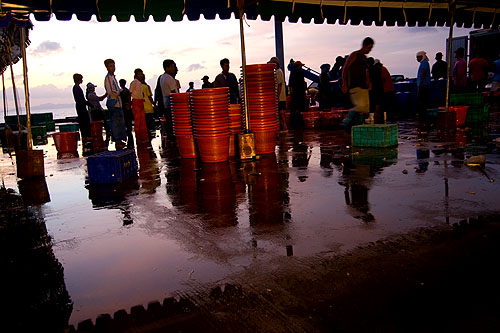

 I'm currently on Ko Pha-Ngan, a beautiful island in southern Thailand. At the moment, the water is clear, the weather sunny and I'm having a great time with old friends. There's only one downside: the food is bloody awful. Actually, that's a bit too strong. The food here isn't unsanitary, or rotten or even that badly prepared. It's just phenomenally bland. A boring, uninteresting approximation of Thai food for gastronomically timid foreigners. To make things even worse, every restaurant on Haad Yao seems to have the identical menu, and they staunchly refuse to vary from this. Among the more bizarre things that I've been served is something called Haad Yao fried rice (pictured above), rice fried with ketchup and chicken, and wrapped in a thin omelet. You can opt for the classic Thai dishes, but unless you're a fan of limp, salty 'kana with garlic', greasy phat thai, or milky tom khaa, you're screwed.
I'm currently on Ko Pha-Ngan, a beautiful island in southern Thailand. At the moment, the water is clear, the weather sunny and I'm having a great time with old friends. There's only one downside: the food is bloody awful. Actually, that's a bit too strong. The food here isn't unsanitary, or rotten or even that badly prepared. It's just phenomenally bland. A boring, uninteresting approximation of Thai food for gastronomically timid foreigners. To make things even worse, every restaurant on Haad Yao seems to have the identical menu, and they staunchly refuse to vary from this. Among the more bizarre things that I've been served is something called Haad Yao fried rice (pictured above), rice fried with ketchup and chicken, and wrapped in a thin omelet. You can opt for the classic Thai dishes, but unless you're a fan of limp, salty 'kana with garlic', greasy phat thai, or milky tom khaa, you're screwed.
 You've undoubtedly been re-directed here from RealThai, my former Thai food blog. Thai food fans don't despair just yet--all my previous entries have been moved here, and I'm still living in Thailand and the bulk of my entries will continue to emphasize Thai eats. However, I'm doing a lot more traveling these days and wanted a more general forum from which I can share my food discoveries. I also like the idea of a 'hub' of my own work, and if you've got the time to explore the site a bit, you'll also find a
You've undoubtedly been re-directed here from RealThai, my former Thai food blog. Thai food fans don't despair just yet--all my previous entries have been moved here, and I'm still living in Thailand and the bulk of my entries will continue to emphasize Thai eats. However, I'm doing a lot more traveling these days and wanted a more general forum from which I can share my food discoveries. I also like the idea of a 'hub' of my own work, and if you've got the time to explore the site a bit, you'll also find a  This is my first post at my newly-redesigned website. I'm still learning how to post and use some of the new functions, so it's something of work in progress. Once I get everything ironed out I'll start publishing RealThai here and you'll be able to check out all my blogs, as well as a portfolio of my work and samples of my published work, all at one convenient hub.
This is my first post at my newly-redesigned website. I'm still learning how to post and use some of the new functions, so it's something of work in progress. Once I get everything ironed out I'll start publishing RealThai here and you'll be able to check out all my blogs, as well as a portfolio of my work and samples of my published work, all at one convenient hub.










